Whether you’re drawing or stitching portraits, they can be quite a challenge to make. After all, the finished result should resemble your subject, and achieving that likeness has tested many artists.
A face can tell us more about a person than any other physical attribute – the twinkle of an eye, the curve of the mouth – the flaring of the nostrils. I once knew someone who doubled his stake in a business deal based on a twitch of his opponent’s mouth!
We asked seven artists what attracts them to stitching portraits. Is it imitating expressions, giving depth to the eyes, using contours and shading, or any other of the fascinating array of features that people present?
Our portrait artists include Ruth Miller whose highly detailed and large scale embroidery also stimulates contemplation of her subject matter, and Sue Stone, who is an expert at using stitch to create texture. Then there’s Rosie James, who picks images of people in crowds to machine stitch. Ditte Sørensen likes to deviate from the norm and work intuitively, while Andrea Cryer’s expressive machine and hand stitching invokes emotion. Julie Sarloutte’s American pop culture style features familiar celebrities, and, finally, Jane C Thom (better known as jaygel_threads on Instagram) explains how she stumbled upon portrait embroidery and found she could do that better than painting.
Using hand stitch, machine stitch and mixed media, these artists reveal how stitching portraits is personal, creative and, importantly, can be mastered with practice.
Ruth Miller
On the face of it Ruth Miller is an embroiderer. But, on further examination, there is so much more to her work than simply stitches. From the layer upon layer of colour and stitch that make her life-sized artworks incredibly realistic, you notice a depth and integrity that surpasses the stitches and the materials alone.
The phrase ‘the whole is greater than the sum of its parts’ comes to mind, not only due to the care Ruth puts into her intricate and time-consuming slow-stitched portraits, but also because of the insights to life that she has gleaned through her stitching. But it isn’t just the subject that’s important for Ruth, it’s the narrative, too.
‘Depth of understanding is my goal. I want to know what’s real externally – hence my concern with realism – as well as internally, and my fingers help my eyes understand.’
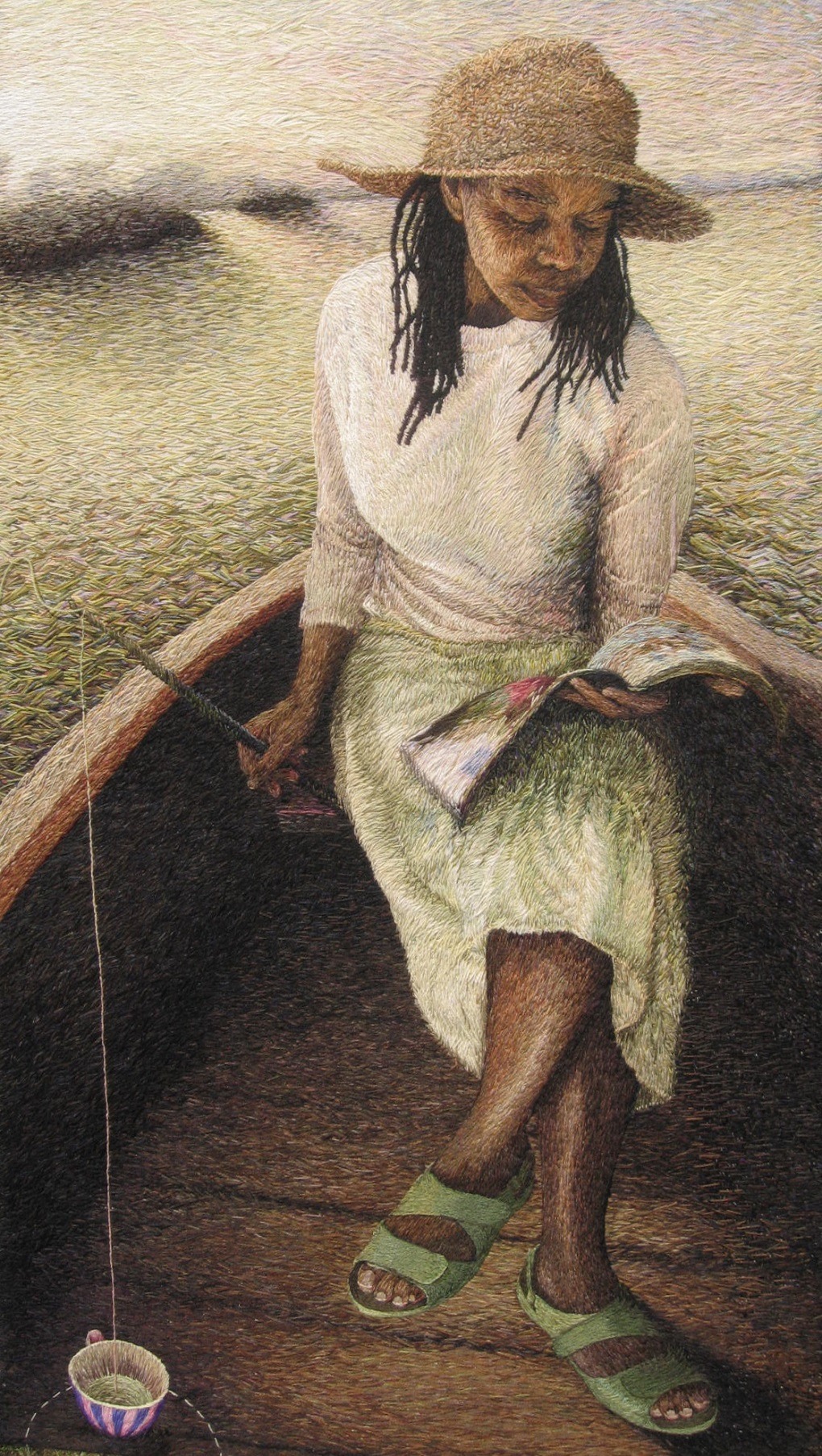
Considered stitches
Ruth Miller: ‘Along the way I developed something I call ‘narrative vision’ – the story I’m trying to tell. I’m committed to telling stories about the joys and challenges of daily life, especially for those living in African-American communities. Either the art-gods provide inspiration or I take a photograph that unexpectedly hints at a direction to take. In the case of Teacup Fishing it was a bit of both.’
The intensive stitching means that Ruth’s artworks may take an average of a year or more to complete.
‘For example, in order to make the edges of an eye curve, I must use several small straight stitches. There is no such thing as a curved stitch. Every stitch is straight and may only look curved because the viewer can’t see where one stitch ends and the next begins.’
Ruth explores colour contrast as a way to set the mood of her designs, which are entirely hand stitched with Paternayan wool tapestry yarns, a three-stranded yarn available in a rainbow of colours.
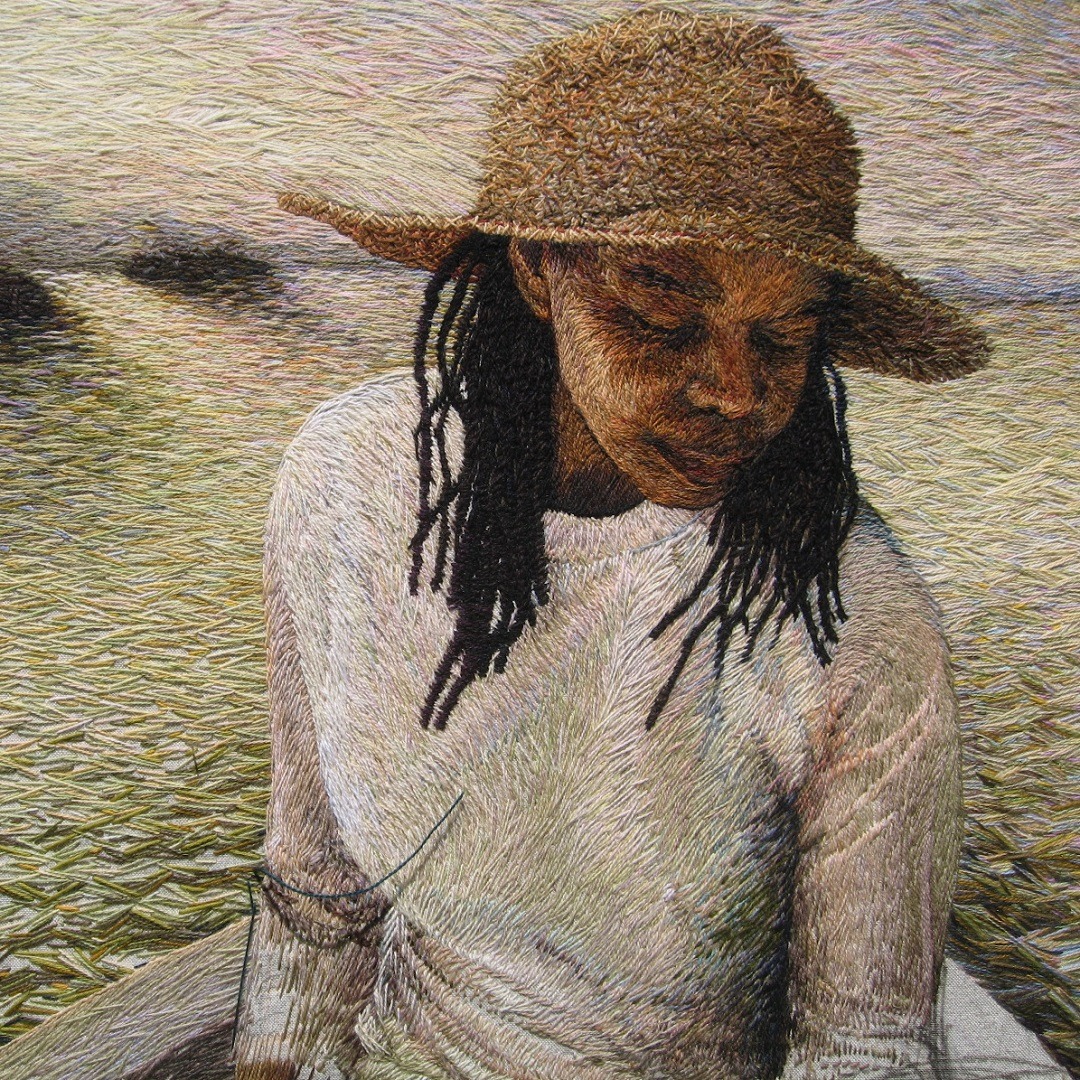
Stitching life’s meaning
Teacup Fishing evolved over several years, partly due to the distant location of her sister Bebe, the model for the artwork, but also because of the slowly unfolding process of the design as the composition took shape. It is a large hand stitched portrait of a figure sitting in a boat on a lake, absentmindedly fishing in a teacup while reading a magazine.
Ruth equates fishing with humanity’s search for the good things in life, and the multitude of ways in which we distract ourselves from the pain of lacking the objects, income, relationships, situations or good health that others enjoy.
‘Amidst distraction, our search is only half-hearted. We seek and accept less, thus limiting our own good fortune’.
Trial and error
After taking reference photos of Bebe, Ruth sketched preliminary drawings to explore options for colour and composition.
‘The original visual conception (a woman fishing out of a teacup) descended out of the blue while I was working on something else, so I made an initial rough sketch to aid my memory.’
Initially, she signified the abundance of life through the presence of a lake in the background, visible through the window, but while transferring the design to fabric, she chose to place Bebe outside, nearer to the water.
Having added a wooden pier and a table for the cup, Ruth then wondered about where to seat the figure. She switched to doing some work on the face, to give her more time to make a decision. In order to complete the face, she needed a more detailed visual reference and, after more photos and drawings, Ruth was able to adjust the image to look more like Bebe.
Returning to the composition’s surroundings, Ruth decided that placing the figure on a boat would make the theme more ironic. So she adapted the design to fit the already stretched background fabric. She had to consider the details of the boat’s interior, the direction of the shadows, and how to fit the boat in with what she’d stitched so far. Her final tweak was to ditch the idea of including a table and place the teacup on the floor, which makes the depiction of ‘absentmindedly fishing’ even more effective.
Ruth admits that the work process for Teacup Fishing was a struggle, and acknowledges the importance of preparation. She says of her approach that ‘if I get out of my own way, I can attain almost anything, and Teacup Fishing speaks of that process’.
‘Embroidery is a slow way to create an image, but being prolific isn’t the hallmark of excellence. In fact, neither is wide acceptance. Remember, YOU be the judge – and be hard to please.’
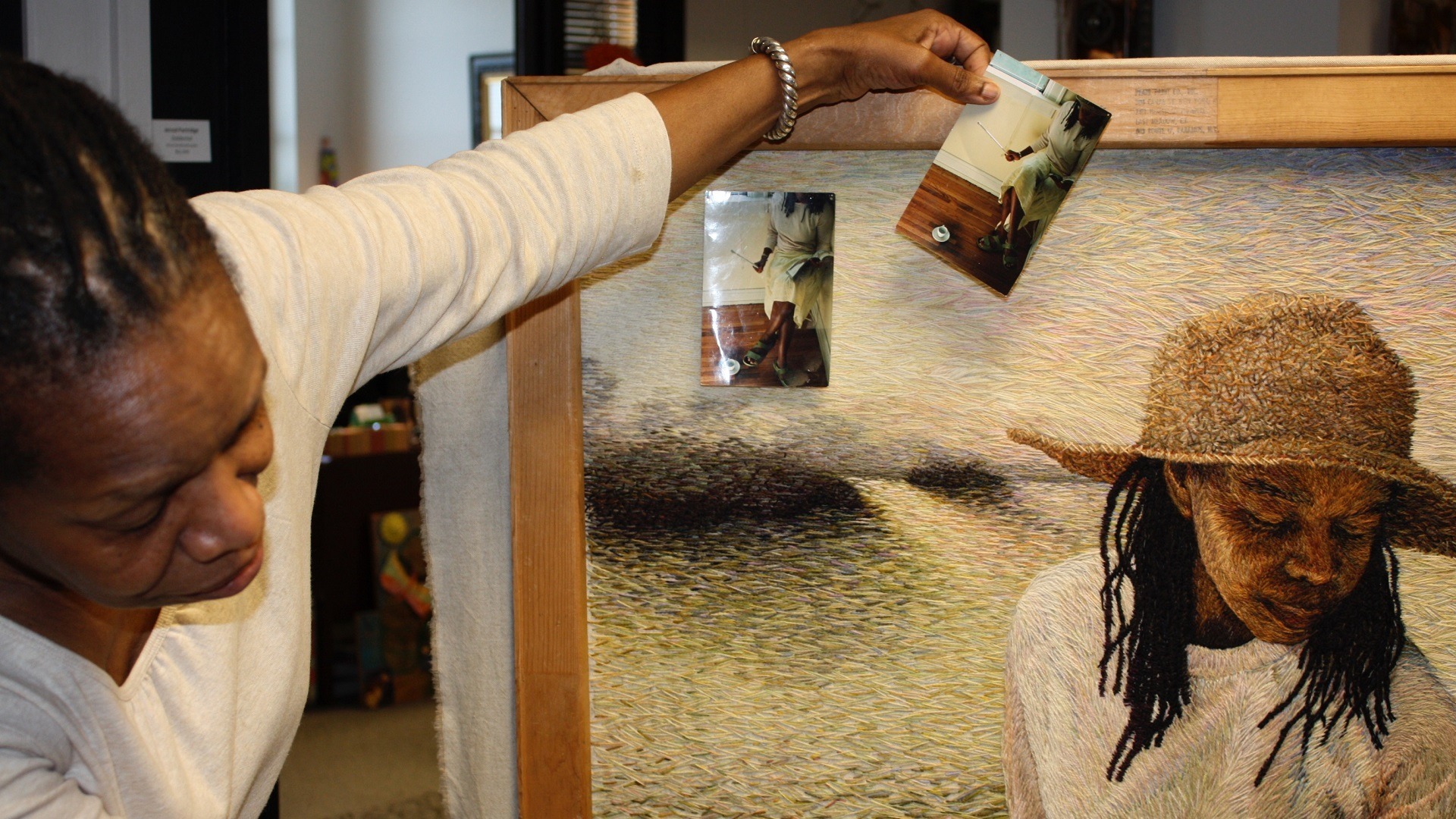
Ruth Miller is based in Mississippi, US. She attended the High School of Music and Art and Cooper Union School of Art and teaches across the US, including at the Penland School of Crafts and the Ohr-O’Keefe Museum of Art. She was awarded the 2019 Mississippi Governor’s Award For Excellence in Visual Art, and her tapestries have been exhibited at the Mississippi Museum of Art, the Huntsville (AL) Museum of Art and in a solo show at the Ohr-O’Keefe Museum of Art.
Website: ruthmiller-embroidery.weebly.com
Sue Stone
Textile artist Sue Stone is best known for her figurative stitched compositions that often convey a partial narrative.
Sue started making portraits after a 28 year gap from stitching. She developed a fascination for old photographs and scrutinising people’s facial expressions, and many became the subject of her illustrative portraits. Her mother and grandmother both died young and Sue took to stitching their likeness as a way of remembering them.
‘The direct contact with the cloth and the slow building of the image as the face emerges is what I enjoy most, and touch is also the reason I work with textural stitch.’
Textural stitch, appliqué and paint
Sue Stone: ‘I grew up surrounded by cloth and making, and I trained in embroidery at Goldsmiths College, London, so I was making textural stitched work long before I ever made portraits.
‘I made A Grimsby Girl’s World Tour – Copenhagen in response to the brief for the 62 Group of Textile Artists’ exhibition Essence shown at the UK Knitting and Stitching Shows in 2022.
‘The brief was to capture the essence of the artist’s creative practice, so this portrait includes a main subject (the portrait of my mum), a narrative, hand and machine stitch, applied fabrics, surface texture and a deliberately limited stitch vocabulary and colour palette.
‘The image depicts my mum, Muriel May Stone, as a young girl and is part of my series A Grimsby Girl’s World Tour. The series features the Grimsby Girl’s imagined journeys to Bogota, Tokyo, Japan, Copenhagen, Madrid, Brooklyn and Vancouver, and the works all combine a portrait from the past with background images from the present day.
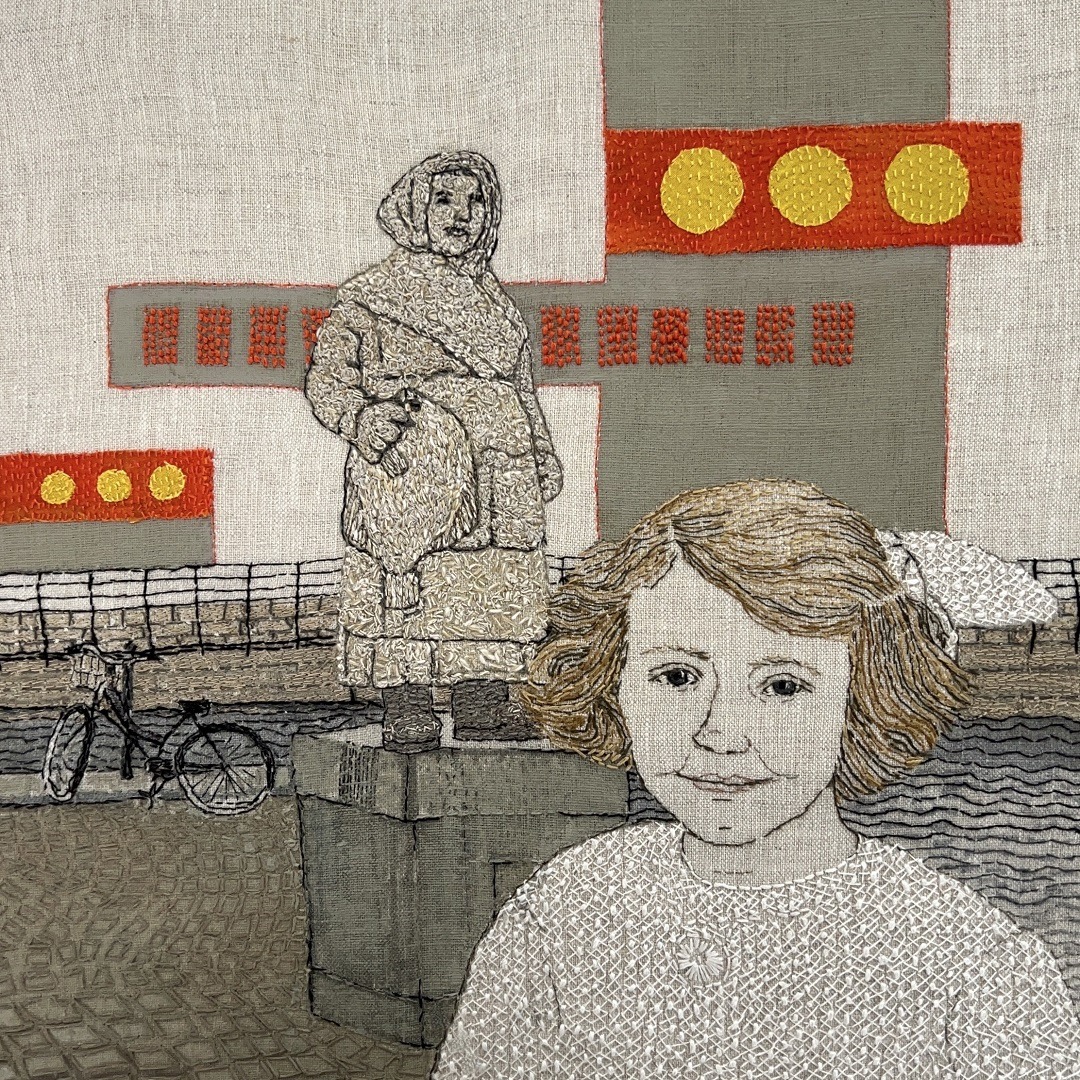

‘My mum never had the opportunity to travel outside the UK in her lifetime so in this series I take her to places that either I, or my work, have visited and enjoyed. When, in 2021, we visited our son Sam and his wife Eliana in Copenhagen where they currently live, I knew my mum would have loved this very cultural city. Sam was born three weeks after my mum died so this is a poignant work depicting the visit of grandmother to a grandson she never met.
‘I am an avid collector of images so on my travels I take lots of photos, mostly of small details I might use in my work, so they were my starting point.
‘I decided to include an image of The Fishwife statue by Charles Svejstrup-Madsen, which stands on the site of the old fish market in Copenhagen and gives a circular link back to my mum’s (and my) hometown. I also included a reminder, in the shape of the orangey red and yellow banners and flags, of a memorable trip to an area of Copenhagen called Christiania, and an image of a bicycle because Copenhagen is full of them.’
Capturing the essence
‘When making this portrait I didn’t primarily aim for a likeness of the child in the photograph: I aimed to capture the essence of the calm, kind and accepting nature of the woman that that child became.
‘After deciding the content, I made a quick paper collage and reduced my images to line drawings to transfer them to fabric. I always use a layer of calico on the back of my work. I stitched the portrait first, then applied acrylic paint and further stitching as well as other materials such as yellow sari strips.’
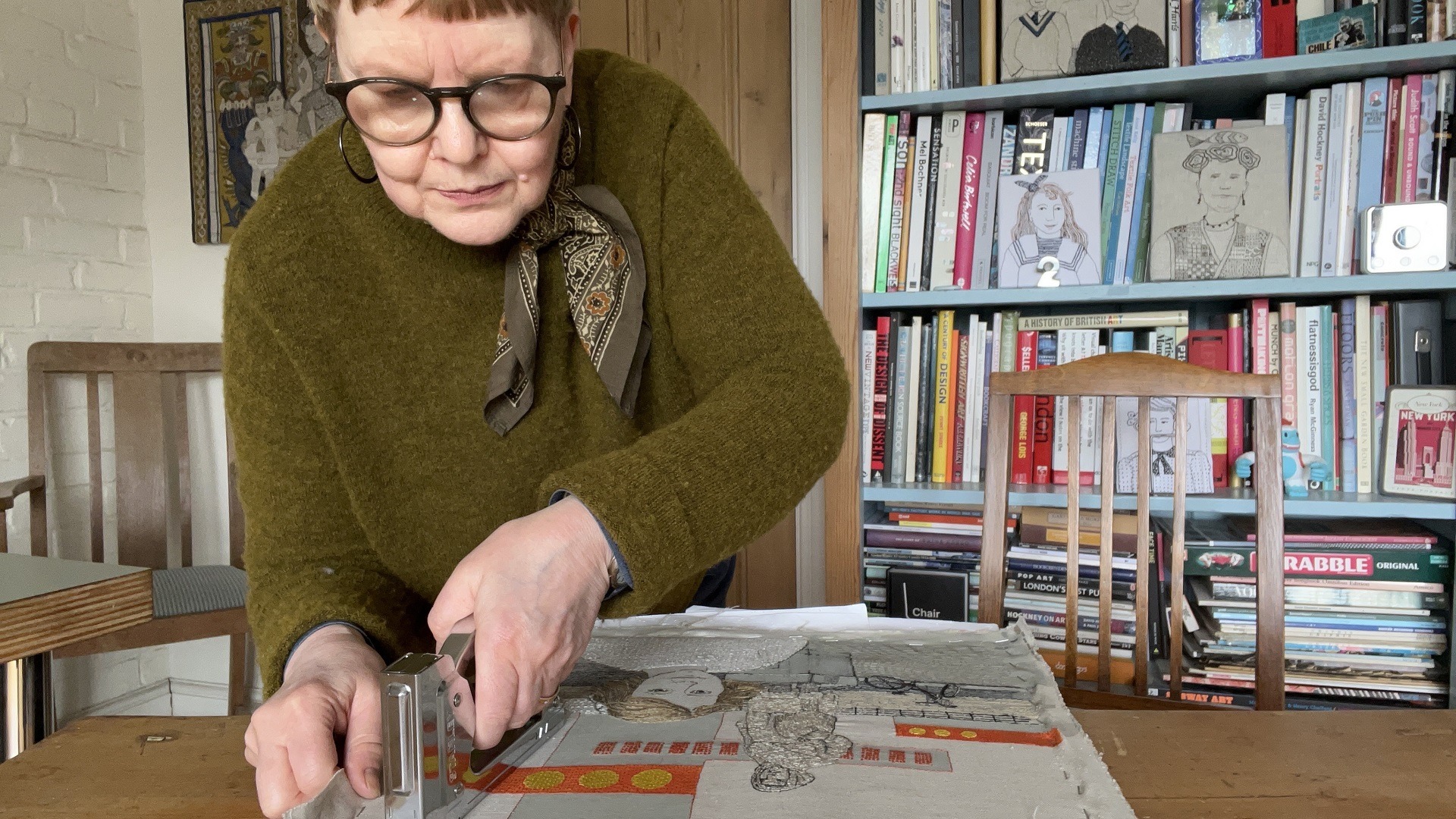
Sue Stone studied Fashion at St Martin’s School of Art, and Embroidery at Goldsmiths College in the 1970s. She is an exhibiting member of the 62 Group of Textile Artists and an elected Fellow of the UK Society of Designer Craftsmen. Sue lives in Grimsby, UK and is a proud mum to Joe and Sam, the co-founders of textileartist.org.
Website: womanwithafish.com & womanwithafish.wordpress.com
Facebook: facebook.com/suestone.womanwithafish
Instagram: @womanwithafish
Rosie James
Rosie Jones regards her sewing machine to be as much a tool for drawing as for stitching cloth. By combining her stitched sketches with techniques such as screen-printing and appliqué, she creates images of people that are multi-faceted. Her dangling threads are intentional too, adding a further dimension to grab our attention.
So, in 2020 when so many turned to meeting on Zoom, it was an opportunity for Rosie to focus on the individuals she saw on her screen.
Rosie James: ‘I think I am drawn to looking at people when they are out and about: I particularly love a crowd. It’s always fascinating looking at a group of strangers and wondering about who they are. While I don’t normally do portraits of individuals, I made an exception during lockdown, as there were no crowds. I was curious to see what people were up to at home.
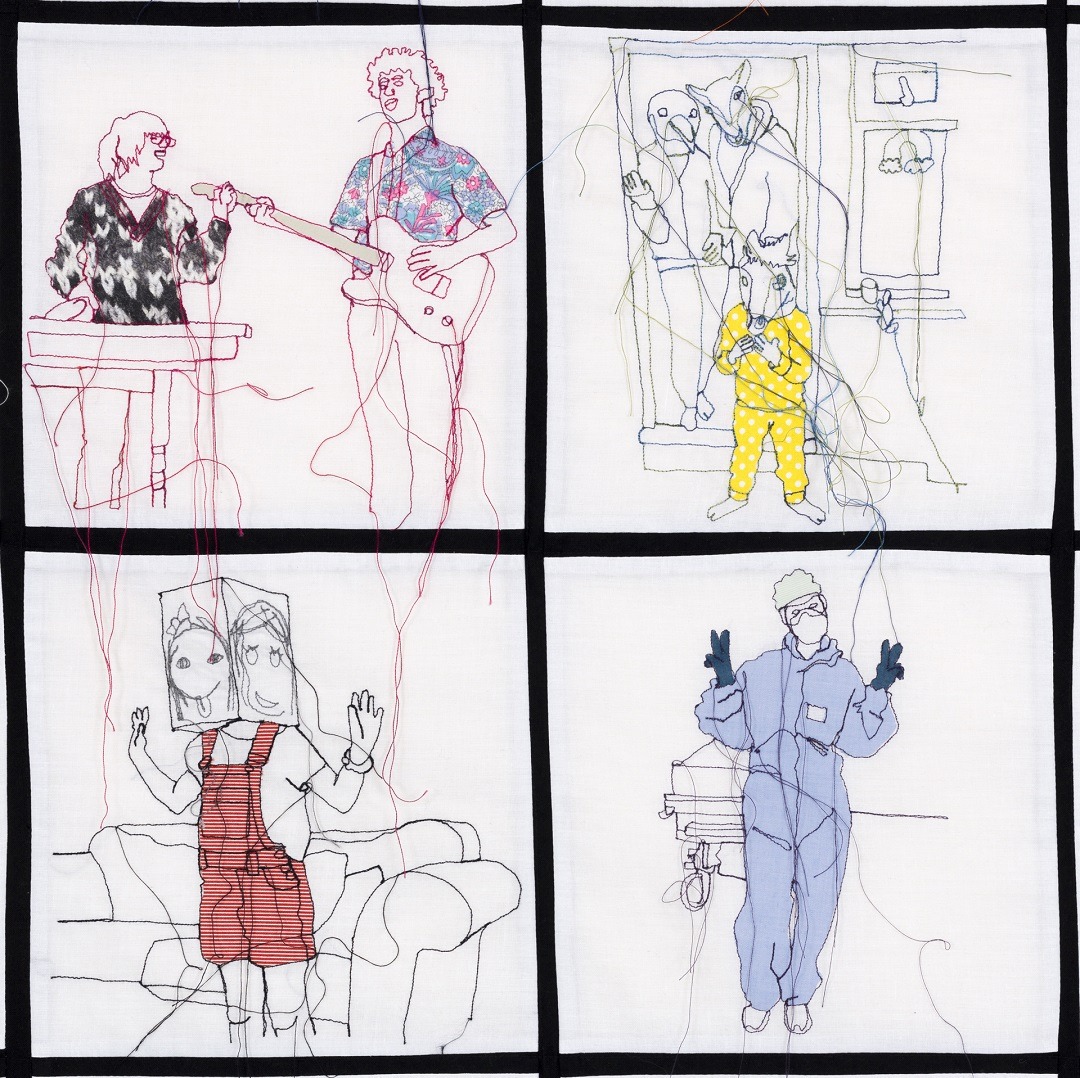
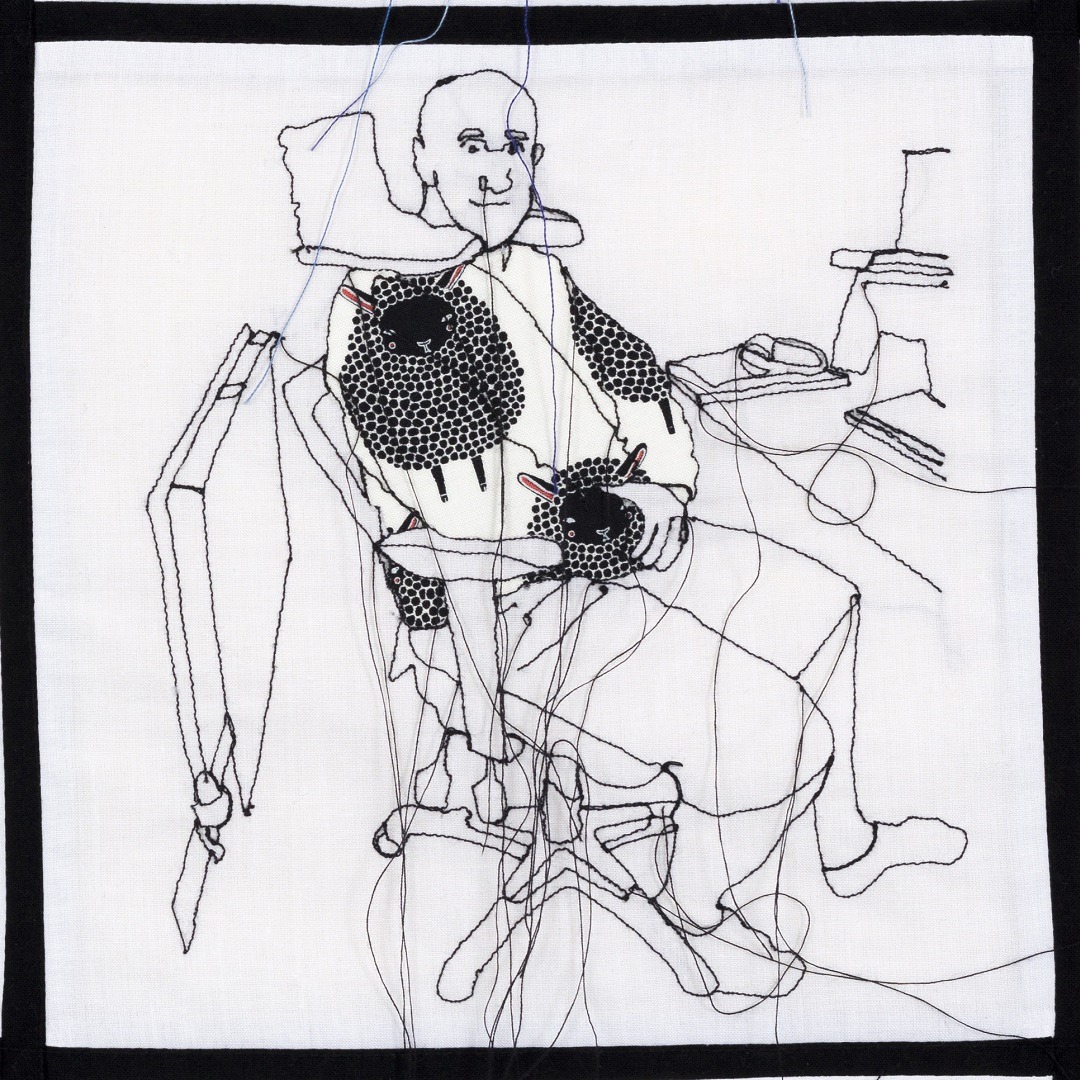
Stitching sketches
‘In April 2020 we were all stuck indoors and all my work had been cancelled so I was looking for something to do. I put a call out on Instagram for people to send me pictures of themselves at home and I would stitch them, just for fun really. I asked them to send photos of themselves from head to toe showing what they were up to indoors or outdoors. I didn’t want just faces, I wanted to see what they were doing.
‘As people sent me their photos I made little 20cm x 20cm (8″ x 8″) stitched drawings of them which I then posted on Instagram. The images they sent revealed a wide variety of activities, such as baking, gardening, jumping on the furniture, dressing up and working from home. There were NHS workers in PPE (personal protective equipment), children having online birthdays, and a couple getting married in the garden. I decided they would look great all sewn together in a grid formation so that the whole thing would look like a massive Zoom session. I stopped at 100, so that there were two panels of 50.
‘I stitched black edges around each square except for the one of myself which is a lime green colour to show that I was the one talking – just like on Zoom!’
Connecting threads
‘The work was made using a sewing machine to stitch the lines. I used a range of colours to stitch the figures and added coloured fabric bits using Bondaweb. The coloured threads were left long and dangling, which I like to do anyway, but in this case it meant that each person in their box had loose threads that dangled into the box below, which I thought showed a nice connection between us all.
‘After I completed it I was able to exhibit it in the windows of a gallery in Rochester near where I live in Kent. Galleries were still not opening to people so it was great that people could see it without having to go inside. After that it was shown at both The Festival of Quilts and The Knitting and Stitching Shows, which meant that a lot of people got to see it, before it was finally sold and went to a new home.’
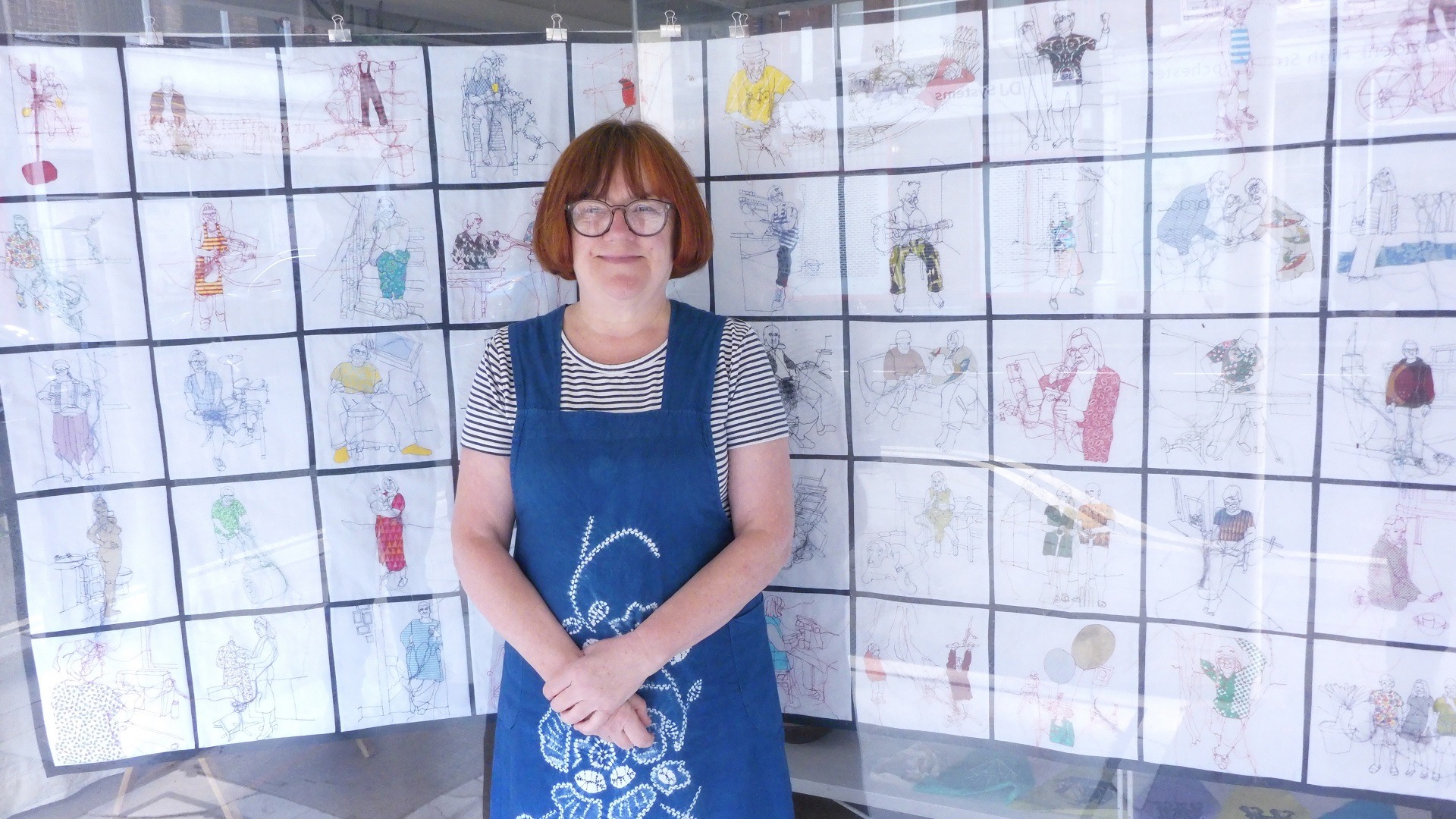
Rosie James lives in a village in Kent, UK. She has a BA in Textiles from UCA Farnham and an MA in Fine Art Textiles from Goldsmiths College, London. Rosie is the author of the book Stitch Draw, published by Batsford (2018).
Website: www.rosiejames.com
Facebook: facebook.com/RosieJamesTextileArtist
Instagram: @rosiejamestextileartist
Ditte Sørensen
Ditte Sørensen likes to deviate from the norm and has an affinity for the less glamorous of her artworks and portraits. She likes the ones that nurture – as well as the ones that sting.
With a wide range of media and materials at her fingertips, Ditte begins from a place of curiosity, with no fixed plan. She works intuitively and that leads her to discover new techniques and ideas.
‘My creativity is normally at its best when I’m in deep water: necessity is the mother of invention.’
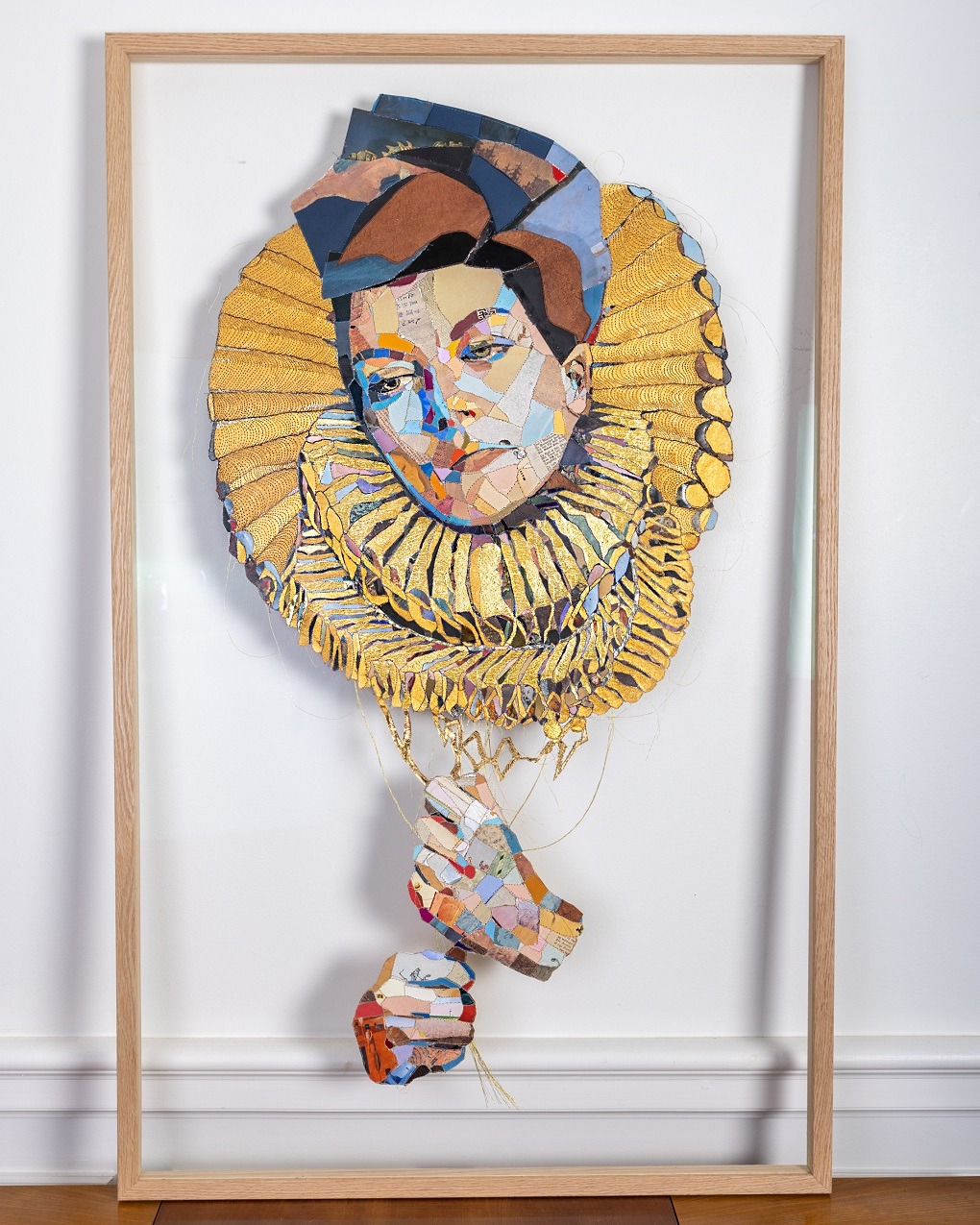
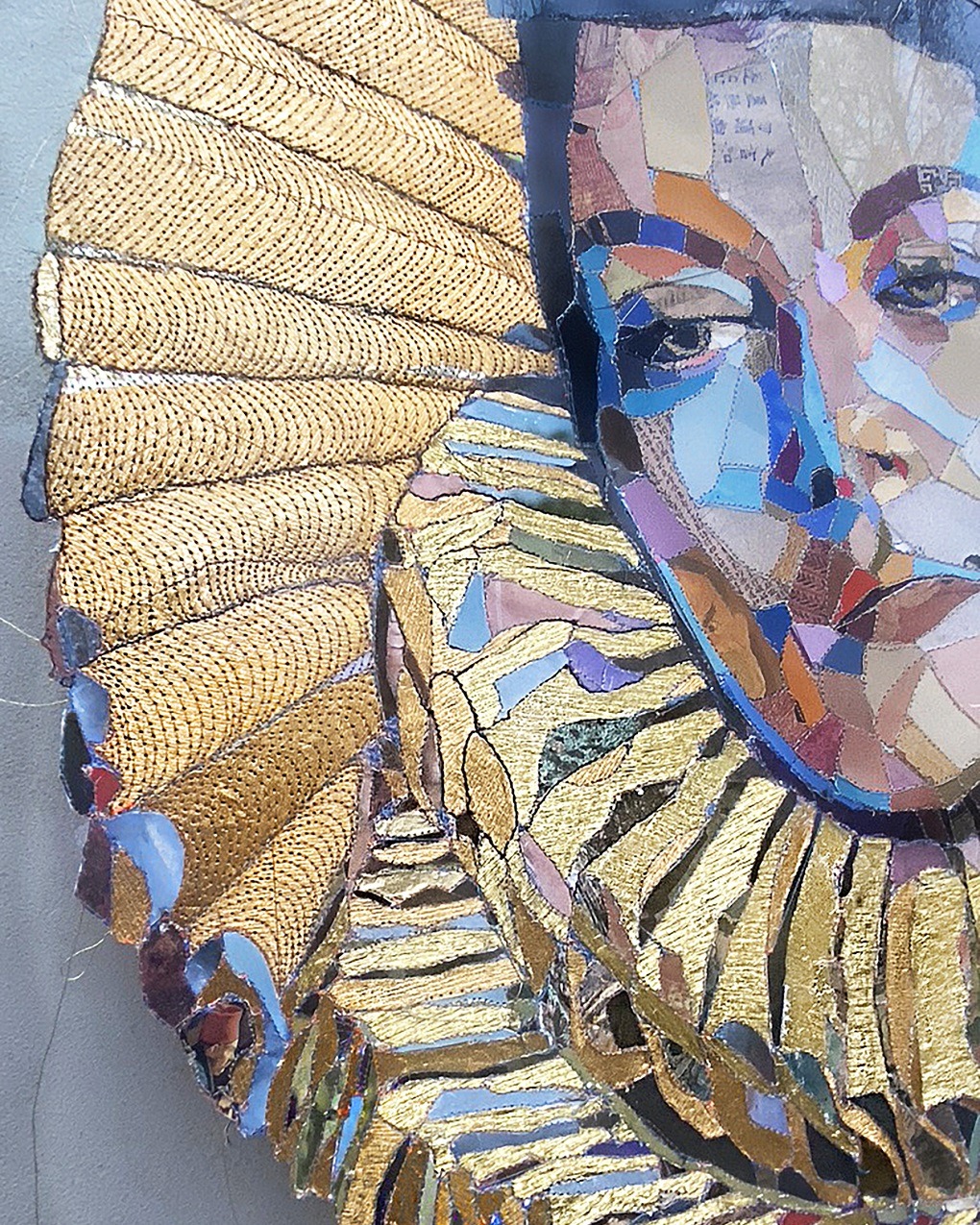
Stories and emotions
Ditte Sørensen: ‘I’ve always been drawn to creating portraits. A face and a posture, or just a hand or a look, can tell a thousand stories and at the same time bring up emotions, both in me when creating them and hopefully in the viewer as well.
‘Woman with Ruff is inspired by the headscarf debate that was very intense in the fall of 2022. My portrait is a commentary on that debate and a wish to symbolise doubt or confusion of identity. Throughout time, head and neck coverings have been used as markers of beauty, power, status, belonging, freedom – but also oppression. In my artwork, the symbols are mixed – the religious, the hope for freedom, the anxiety of losing one’s identity and the courage and despair of unravelling the marker. The inspiration for the work’s head and neck decoration is taken from early Renaissance pipe collars mixed with the design of the pipe collar that is used today by priests in the Danish church.
Just begin it
‘The portrait is made as a sewn collage of paper, books and fabric and some leftover leather from my homesewn motorcycle saddlebags.
‘As I started the piece, I didn’t know what the outcome would be. The overall idea was there – an expression of melancholy and the two types of ruff in gold that changed status through time.
‘Nor did I have an exact plan of how to create the portrait, or what materials to use, except that the ruff should highlight the face and be in gold. I actually started making it in real 23 karat gold, but it didn’t live up to my expectations. Nevertheless, as I worked the ideas came and it took shape.
‘When I’m creating pictures, it’s never about ‘my story’ but more about telling a story, and parallel stories, based on my use of materials. Sometimes I integrate words from a book to illustrate the overall feeling of the portrait – or maybe even conflict with it. Rather than creating a recognisable impression of a person, I often prefer to build it through symbols in a playful way.’
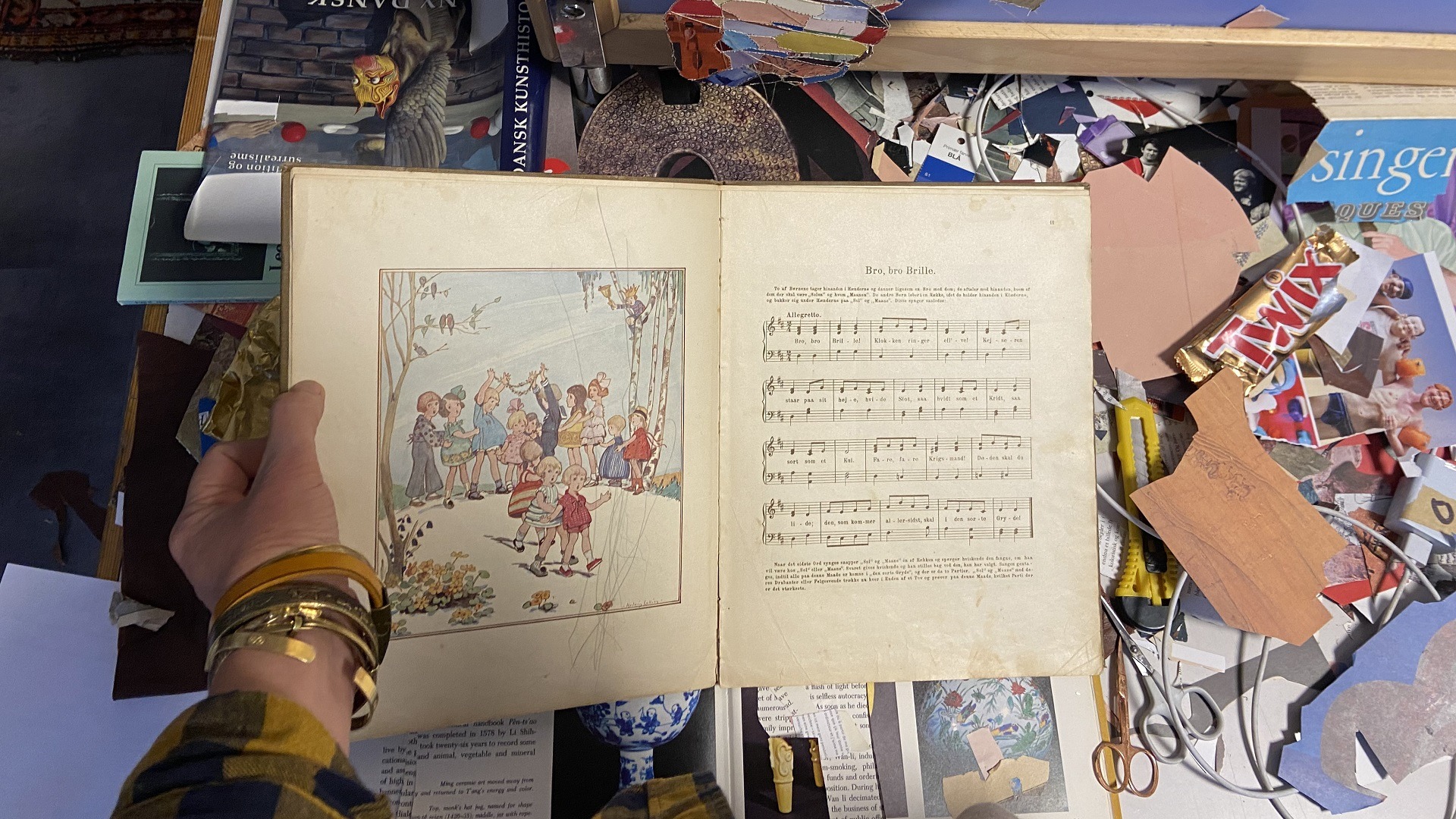
Ditte Sørensen has a degree in textile handicraft and education. She has featured in many publications and exhibitions and teaches workshops from her studio in Copenhagen.
Artist website: www.madstitch.com
Facebook: facebook.com/madstitch.sewnart
Instagram: @madstitch
Andrea Cryer
Andrea Cryer is a textile artist who draws with thread, creating unique portraits with the appearance of pen and ink illustrations. After leaving her career as a solicitor and taking a degree in creative art, fine art and textiles, Andrea now feels most happy when stitching freely on her old Bernina sewing machine.
One of her first and favourite pieces, a large scale diptych called Kath 18 & 88, consists of two machine and hand stitched portraits of her late mother-in-law, pictured 70 years apart. The two images of Kath, hung side-by-side, truly capture her spirit and essence.
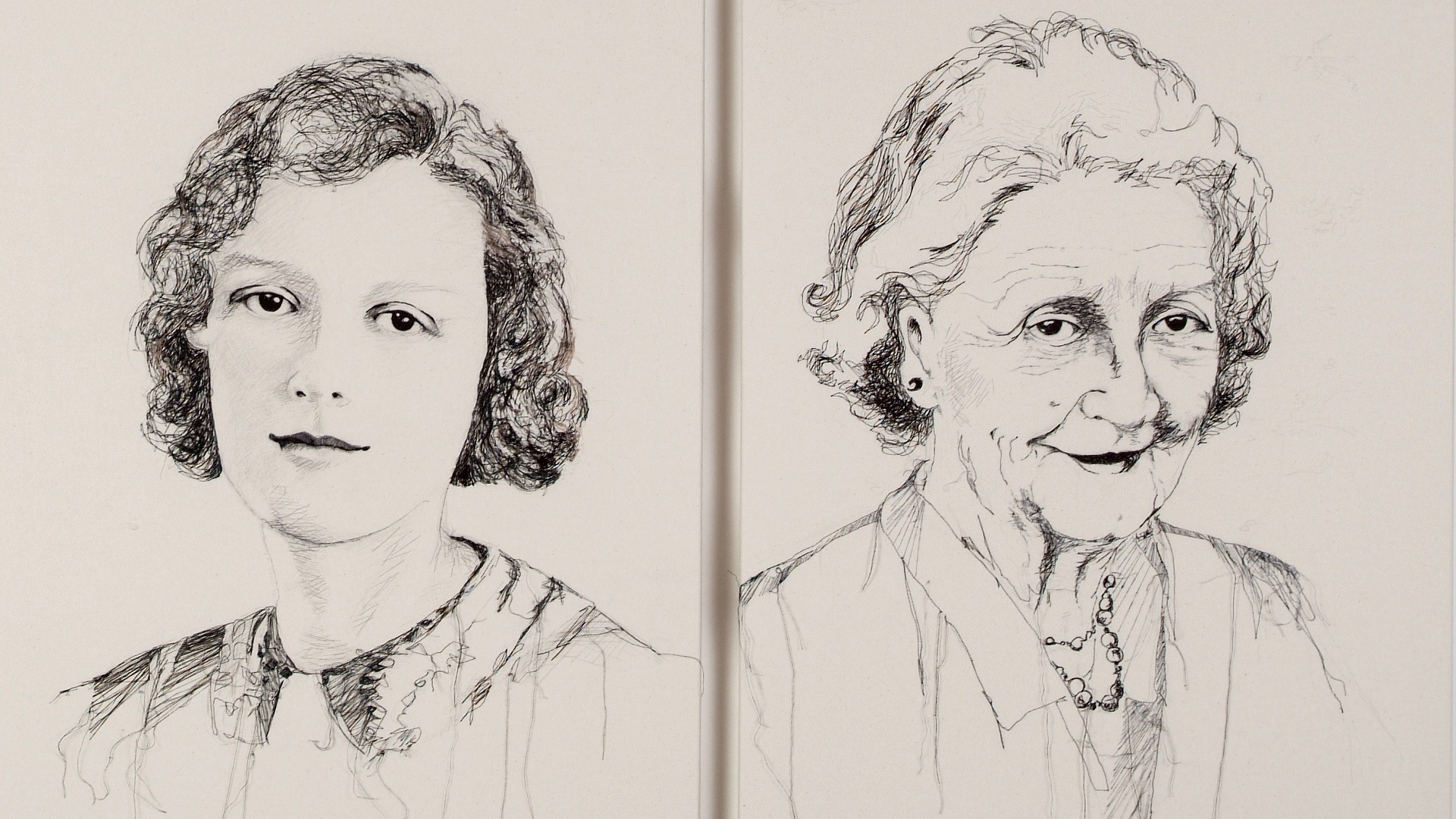
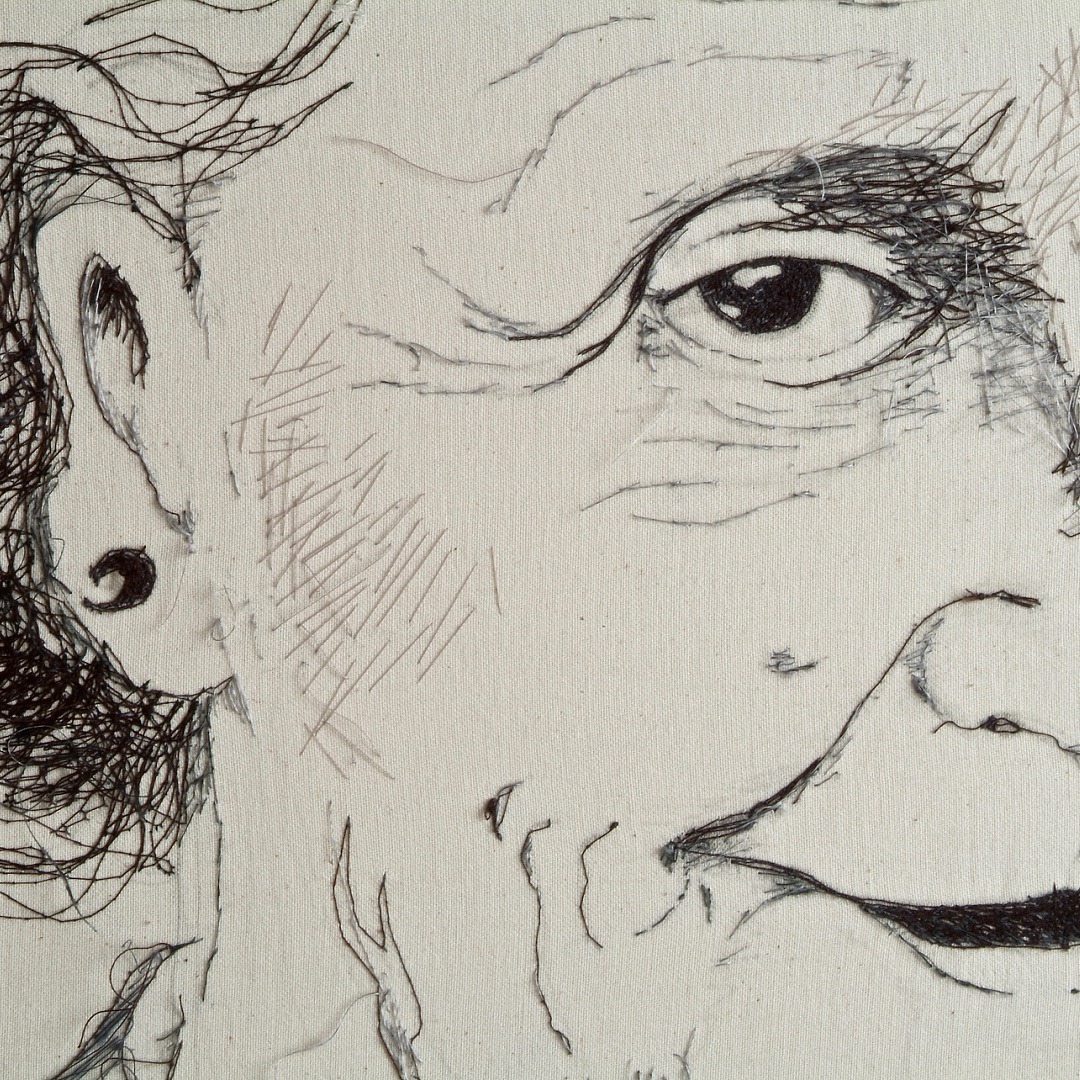
Threading in hair
The first is based on an old sepia photograph of Kath when she was 18. The second portrait is from a photo of Kath aged 88, taken when she visited Andrea for tea one afternoon.
Andrea Cryer: ‘She had that same wistful look in her eyes as she had when she was 18, so I quickly captured it in a photo. I tried to retain that connection in the two portraits. Kath was a lovely lady.
‘It wasn’t until the final year of my degree, working with etchings, that I started to explore the idea of drawing with thread using an ordinary domestic sewing machine.
‘Initially, I’d had fun creating monoprints, carborundum and drypoint portraits of Kath on fabric and paper back in the print studio, but I was still looking for something extra. I had also made paper sketches and played around with size and position, but nothing worked in the way I wanted it to.
‘I borrowed an old portable overhead projector and after experimenting with flashing the images onto my living room walls, I settled on the idea of two large individual drawings.
‘It was then a bit of a eureka moment when I thought maybe I could draw the images on fabric and ‘wouldn’t using thread’ be an interesting idea!’
‘I tackled Kath 18 first, and when that was almost complete, I began working on Kath 88. I started with the eyes which are densely machine stitched with brown threads. Each mouth has a fine machine-drawn line as part of the outline but is mostly stitched by hand using satin stitch and varying lengths of backstitch.
‘The hair began as machine stitch and was finished with differing lengths of hand stitching in black, grey and brown yarns. The younger Kath has some of my daughter’s hair stitched in with the threads.
‘Threading my daughter’s hair into Kath’s stitched hair was a very simple and personal way to achieve this. It also maintained the idea of mark-making, ensuring that the drawings were composed of lines on fabric, reflecting the use of lines in etching.
‘The older Kath contains thread from one of her skirts, which I had unpicked and reused.
Thread as ink, needle as pen
‘The two Kaths were my first real attempts to make marks using thread as my ink and needle as my pen. They were my initial inspiration. I felt a new affinity with the process, which I could work on either at university or at home.
‘I don’t stress too much about the stitched marks I make. I am not looking for perfection and positively embrace happy accidents. Having said that, though, it does take practice. I am a confident stitcher because I have been doing it for a long time!
‘I leave threads loose as part of the drawing to give an element of spontaneity and movement to the image.’
‘The two drawings are each 30″ x 50″. Their size makes an impact. They work best when displayed side by side or opposite each other. It’s then that the viewer can truly see the relationship between them. The story behind the making of Kath 18 & 88 resonates with the viewer, and displaying the portraits together invokes emotion.’
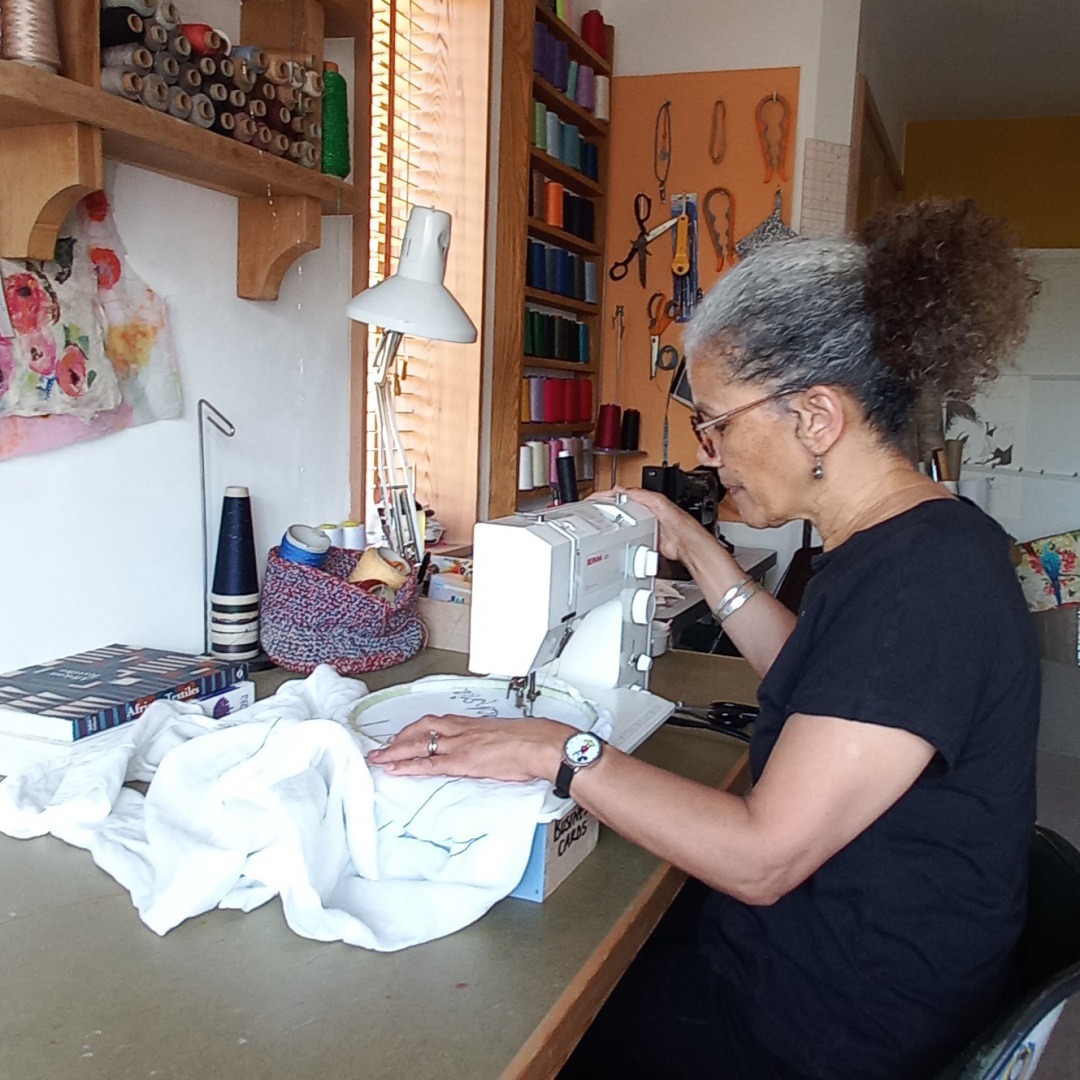
Andrea Cryer graduated from Bath Spa University with a BA (Hons) in Creative Art (Fine Art & Textiles). Her work has been exhibited globally, including the Bath Art (2018) and Windsor Contemporary Art (2017) Fairs. Andrea has twice been a finalist in the Hand & Lock International Embroidery Competition (2016).
Website: andreacryer.co.uk
Facebook: facebook.com/andreacryer
Instagram: @andreacryerartist
Julie Sarloutte
Julie Sarloutte specialises in American style pop culture portraits. Her pictures are both colourful and expressive, and the way that Julie combines paint and thread gives them the appearance of oil paintings.
Whether you’re a Game of Thrones fan or not – or are familiar with the characters of Jon Snow and Daenerys Targaryen – it’s easy to detect both their passion and disappointment from Julie’s image, I fell in love with an illusion of you. The body language, facial contours and expressions in the eyes are all captured in her embroidery.
Magnetic emotion
Julie Sarloutte: ‘It was in 2011/12 that I put down my cross-stitch and embraced the freedom of hand embroidery. I started by embroidering violent images of war and riots; they seemed so far away to me. But after the attacks in Paris, I did an about-turn and started making pop culture portraits. It was a lighter subject and I could relate to it well.
‘I chose I fell in love with an illusion of you, not only because I’m a Game of Thrones fan, but because of its magnetism. It conveys a great deal of emotion and I felt the need to pick that up and share it.
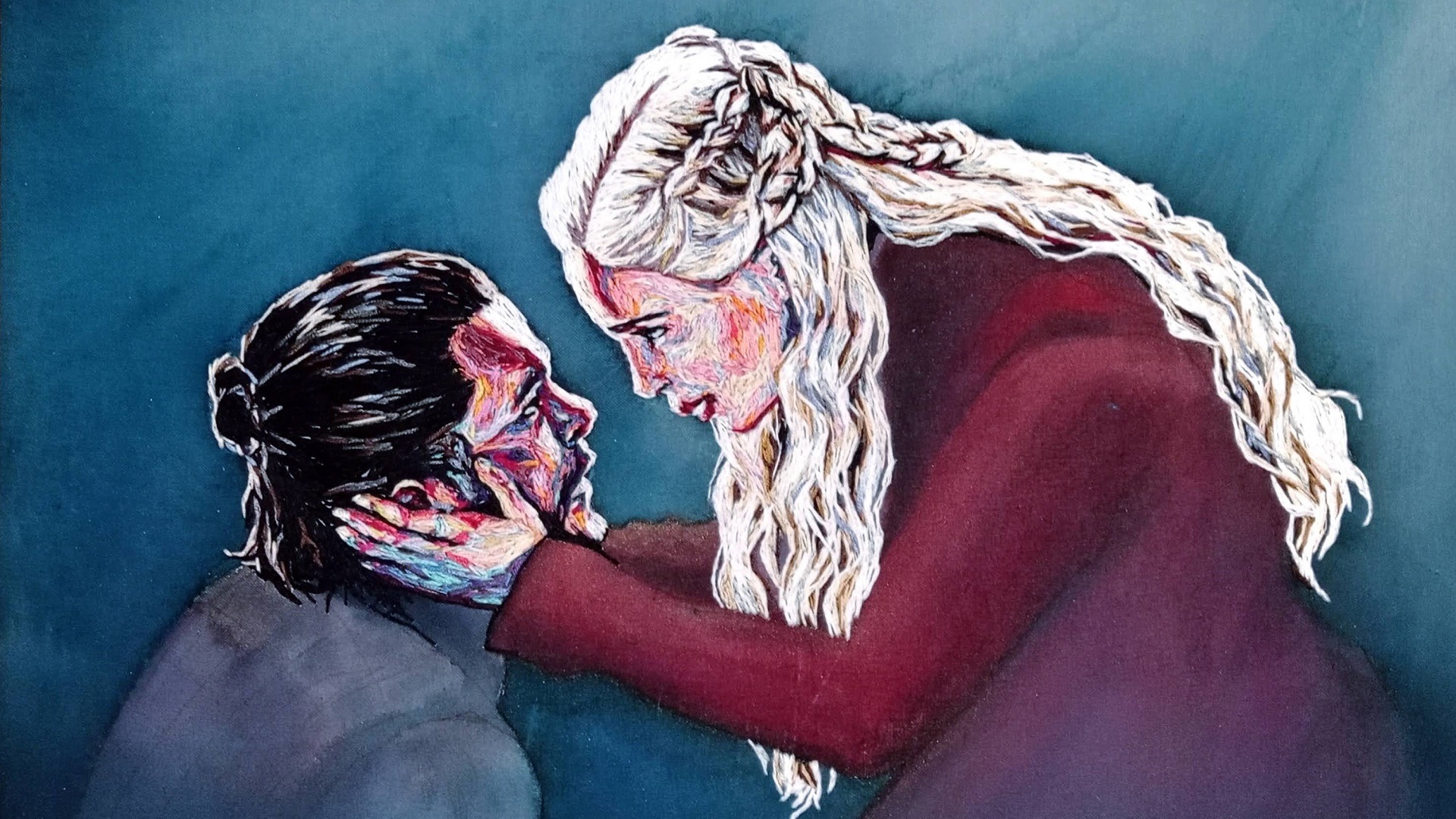
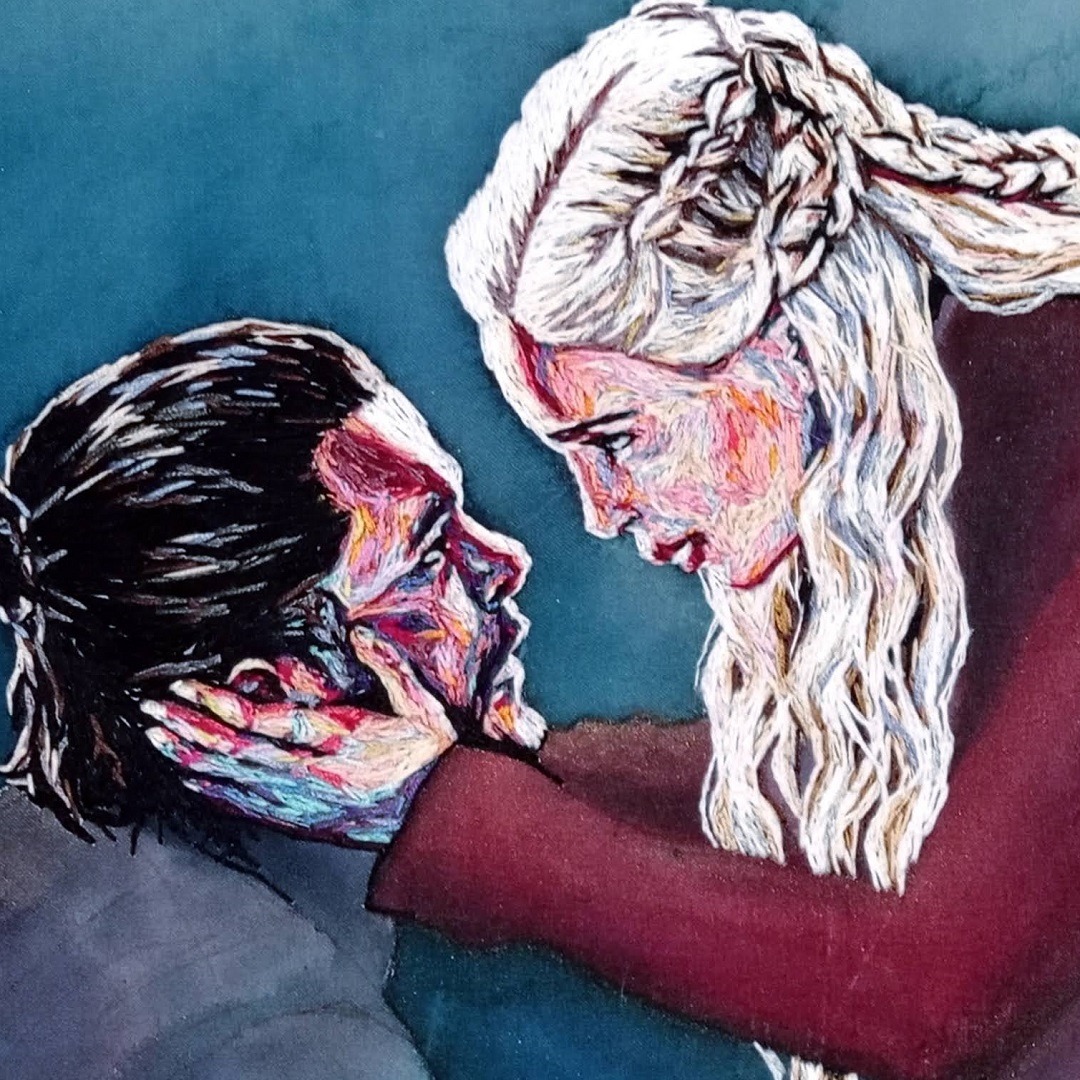
‘I make portraits representing characters from television series and films because I grew up with them and I still enjoy watching them.
When I embroider, I often play the series or the film in the background. It’s fun to be inspired by a scene while I work.
‘I wanted to use my artwork to bring popular culture into museums, so that people who don’t usually go there can recognise some of the characters that I stitch and hopefully feel more comfortable. It’s hard to get some people to visit museums but I find it satisfying to see those from different social levels mixing together. It’s like a little win.
Embroidery as therapy
‘Embroidering is my way of feeling better, a kind of therapy, and when I stitched I fell in love with an illusion of you, I think I just needed it.
‘I painted the background first, like a watercolour, then I embroidered the characters and filled in more detail on their faces, with a focus on bringing out the emotion of the scene.
‘When I finish an embroidery, I post it on social networks to see if people like it as much as me. It’s a satisfying way of knowing whether it was worth all the work. Earlier, I used to try to exhibit them in galleries and museums, but now I have a full time job, I no longer have the time to organise that, so I keep most of my embroideries at home.
‘I fell in love with an illusion of you is on a wall at my home because it’s one of my favourites.’
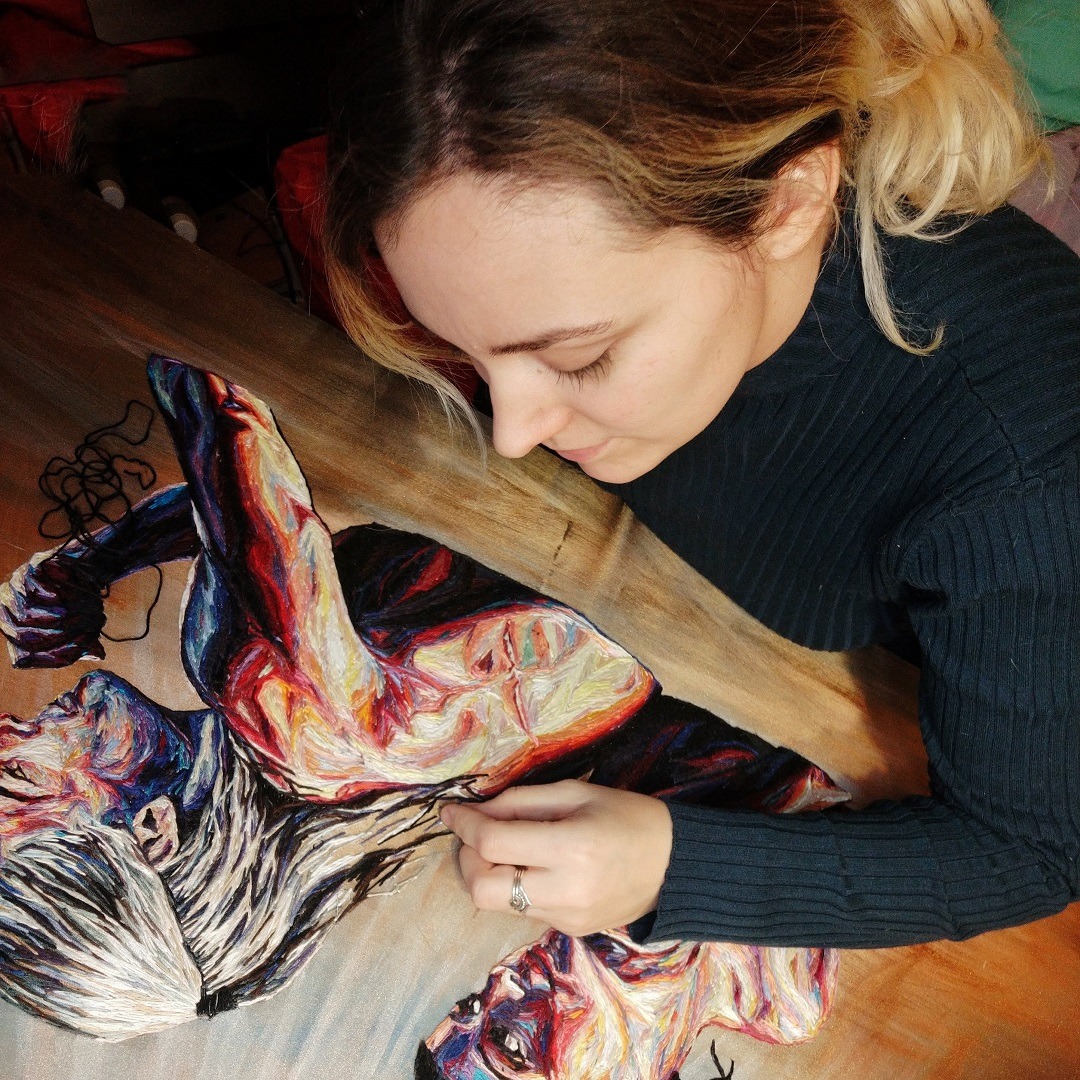
Julie Sarloutte lives and works in France. She has a degree in Fine Arts from the Beaux-Art de Paris.
Website: juliesarloutte.wixsite.com
Facebook: facebook.com/JulieSarloutteArt/
Instagram: @julie.sarloutte
Jane C Thom
Jane C Thom is an experienced art teacher but only stumbled upon embroidery in 2019 when she needed something to help her practise mindfulness. Her colleagues were trying the Stitch a Day challenge and she decided to join in. From the very first stitch she was hooked.
Fascinating, characterful faces
Jane C Thom: ‘Almost immediately one stitch was not enough. I stitched an eye first. Then a portrait of a very old lady. I was following several portrait embroiderers on Instagram and wondered if I could embroider someone people would recognise.
‘My first famous face was Danny Trejo as Machete and he was stitched with crewel yarn. I was then gifted a huge amount of embroidery thread. Siouxsie Sue was my first more refined piece. I see embroidering portraits as a challenge. I have never been able to paint portraits accurately.
‘I was just playing at embroidery when I thought I’d try a famous face. It turns out I was quite good at it.’
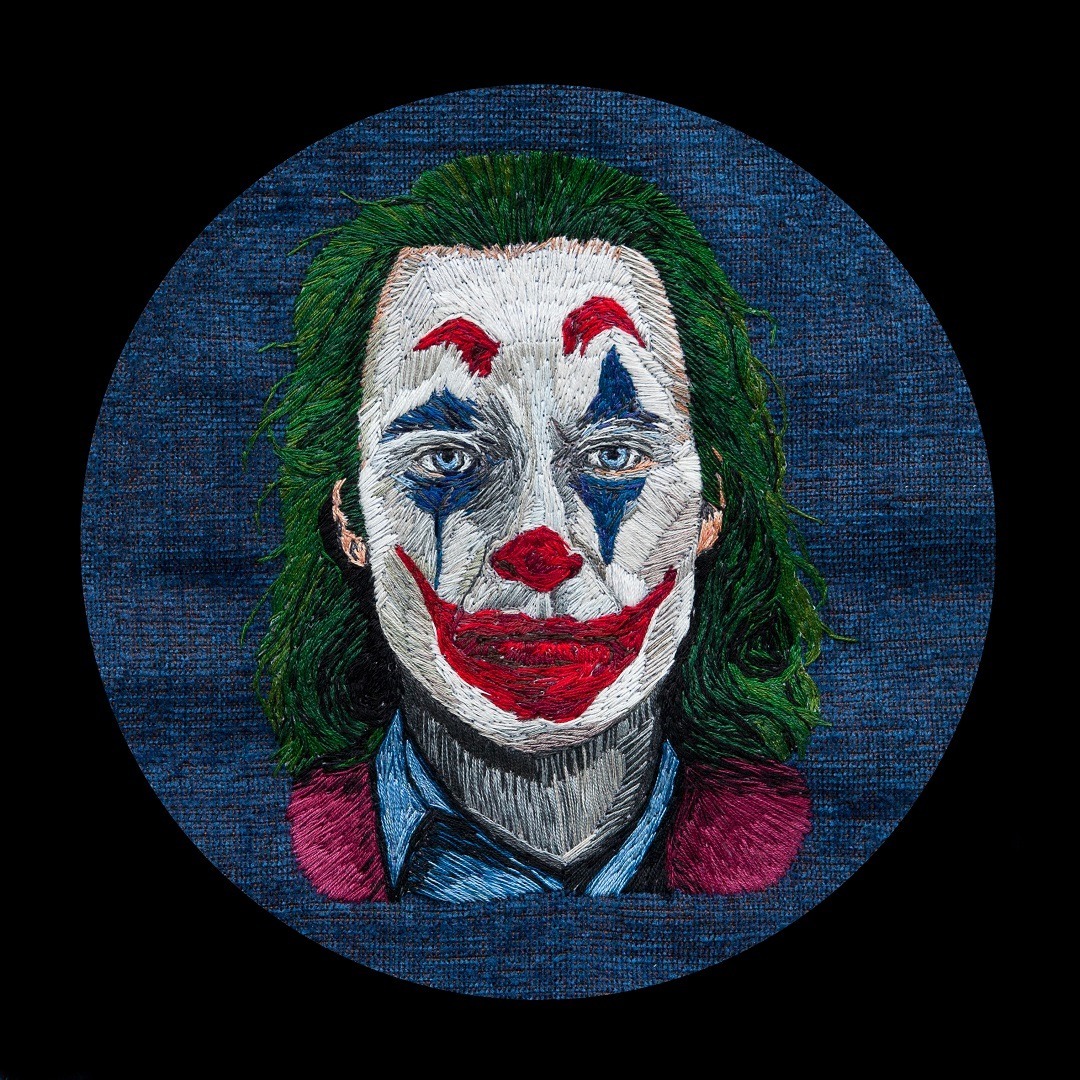
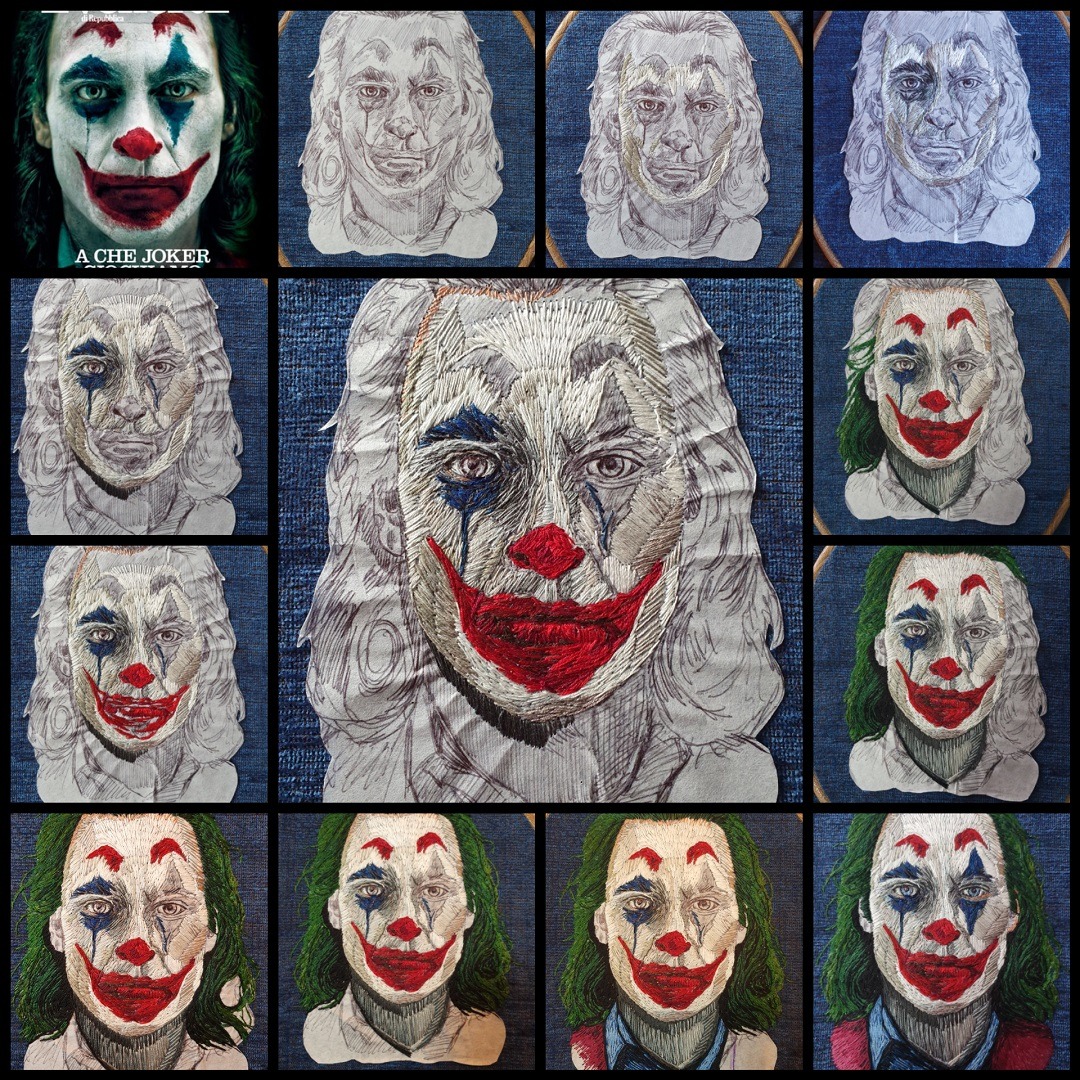
‘My portrait of Joaquin Phoenix in his role as the Joker came about before the film was released. I like to choose faces I find fascinating or characterful and this image struck me as both. The background fabric is an upholstery sample and he is entirely stitched with DMC and Anchor stranded embroidery thread.
Graduated shading
‘The process is always the same: I draw on a self-adhesive stabiliser and shade in the directions the stitches will travel. This is stuck on a background fabric and tacked down for extra security. The original drawing is forever encased within the final portrait.
‘Long and short stitch is my go-to filler. I rarely have just one colour of thread in the needle: two very similar tones help to create the graduated shading. The more the drawing is ‘disappeared’, the more therapeutic and satisfying I find the process. I use a variety of hoops depending on the size of the piece. The Joker took approximately 40 hours over the course of a month to complete.
‘In early 2023 I was part of a joint exhibition in my home town with two other local artists. It was very exciting as it was delayed for two years due to Covid. This was a prize for placing in the top three of the Kettering Open Exhibition in 2019.
‘As this is my hobby, not my job, when I have made pieces for others, they have been gifts. My family and friends are incredibly supportive and many of my pieces have been made with them in mind. I have always been creative and am regularly inspired by my students who have helped me choose some of my subjects.
‘Embroidery was, at first, an easily accessible pastime. Now it’s my passion.’
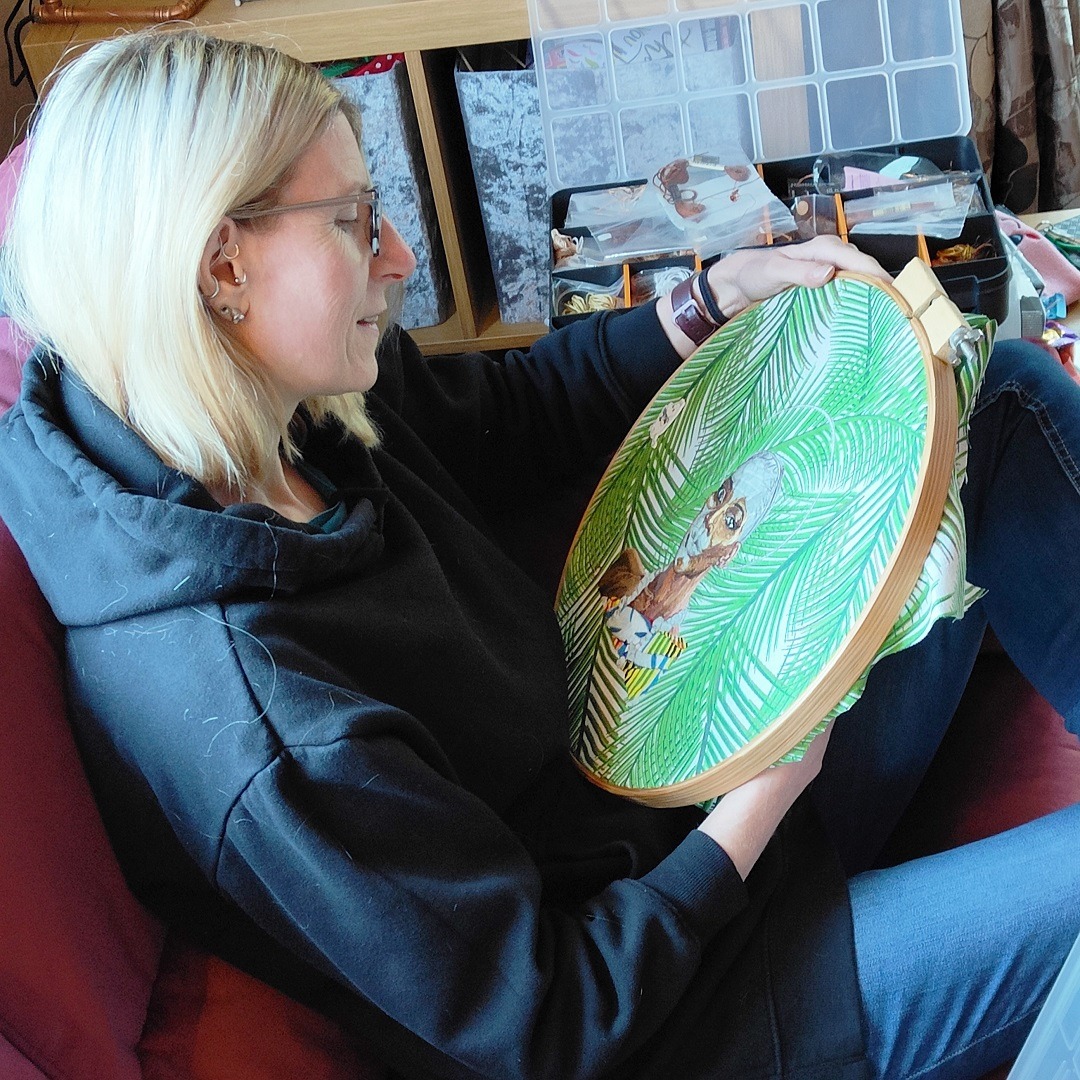
Jane C Thom lives in Northamptonshire, UK. She trained as an industrial ceramicist and has been a full time art teacher for 30 years, specialising in 3D art and design. She is a member of the Society for Embroidered Work.
Instagram: @jaygel_threads
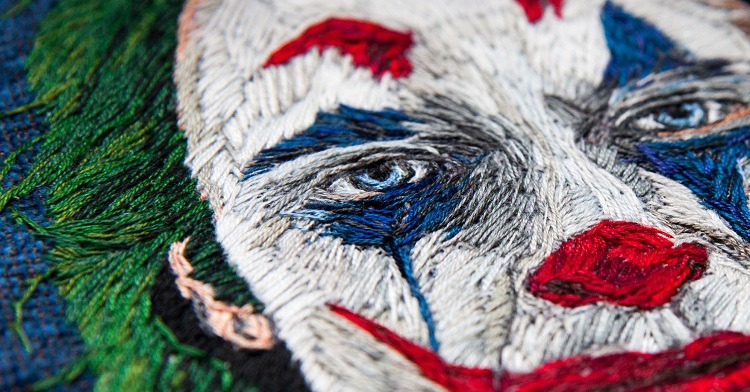

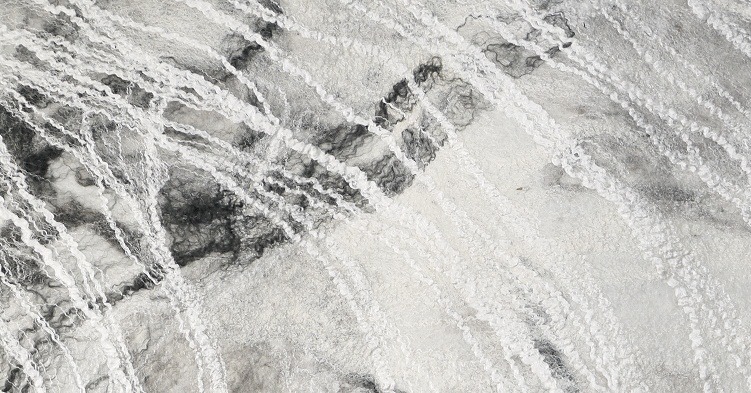
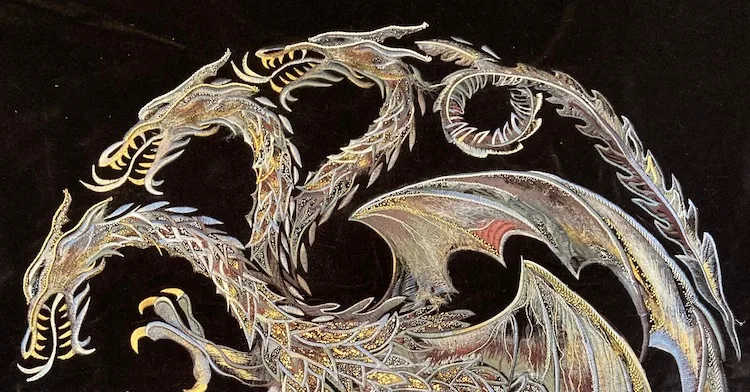
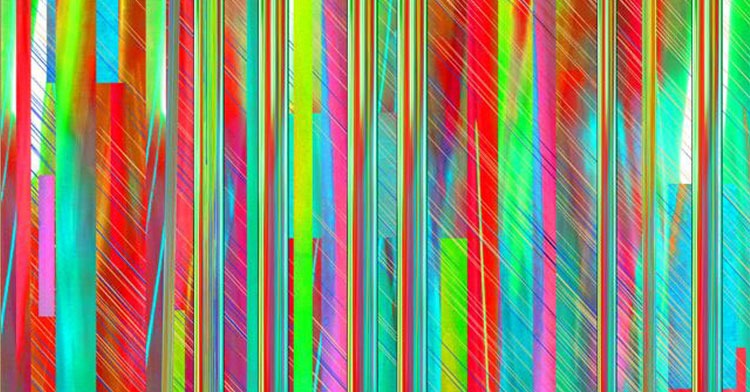
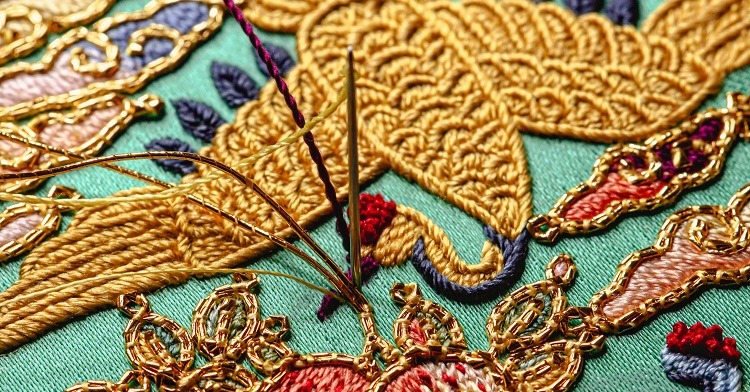
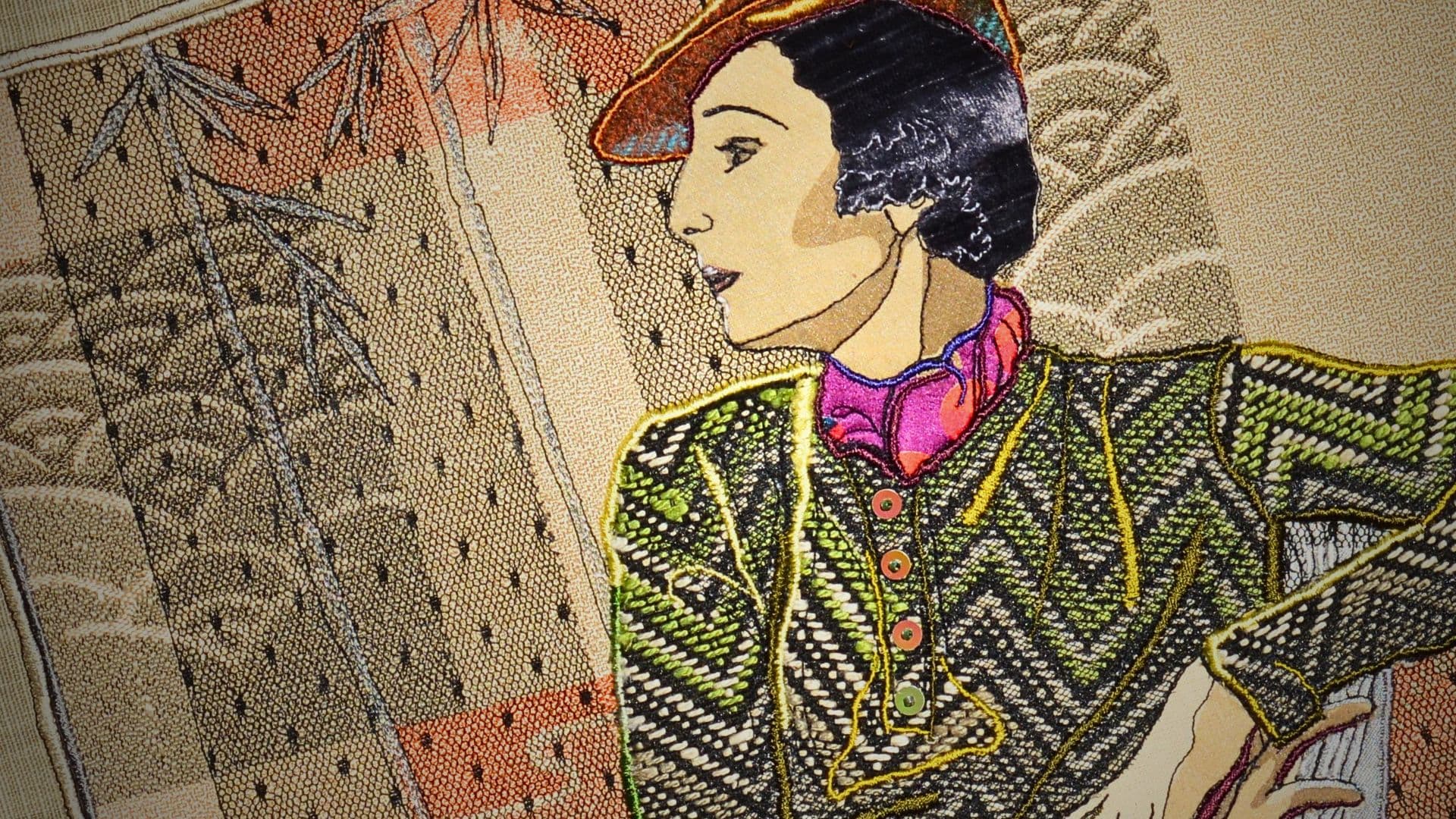
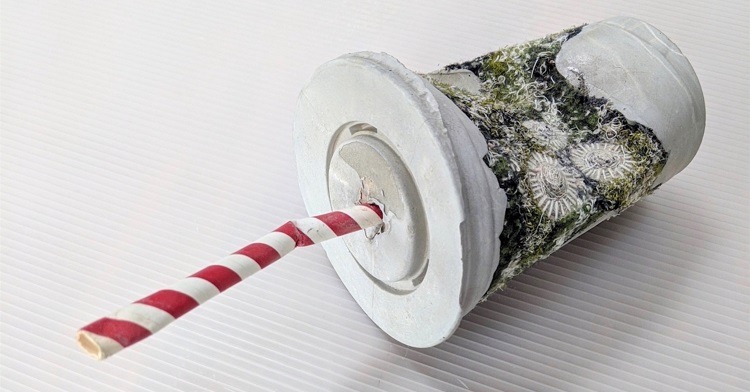
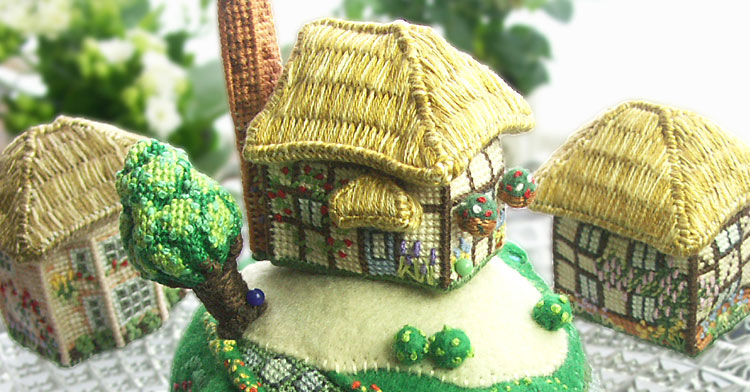
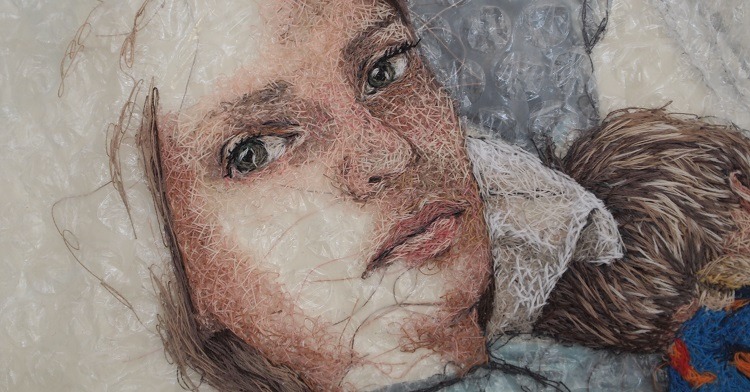
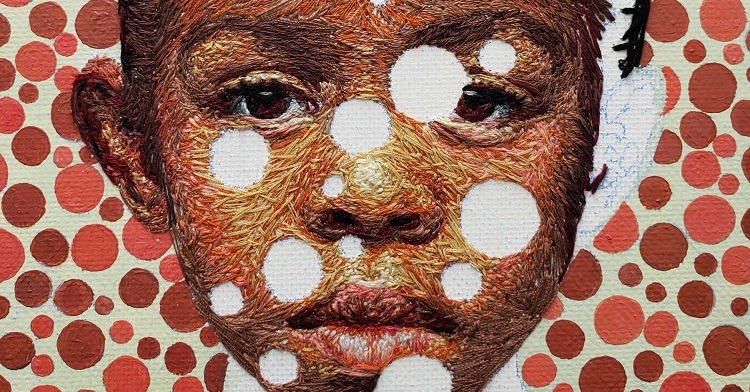
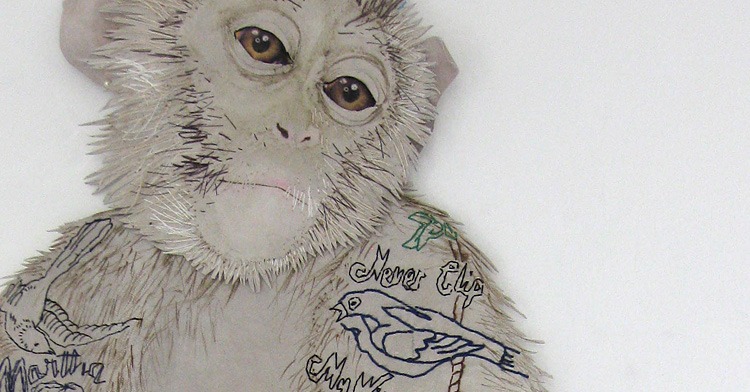
15 comments
Donna
What a fascinating piece on these very talented artists. I had never seen this type of stitching and read about each artist in awe!
Siân Goff
They are awe-inspiring indeed! Stitched portraits are especially complex… Thanks for your comment, Donna.
Jacquelyn
What an incredible article. These artists are truly inspiring.
Siân Goff
Thank you so much for your kind comment, Jacquelyn. We love platforming the work of talented textile artists. Glad you enjoyed the article!
Christiane
Thank you for this fabulous report. Unfortunately, I stop as soon as it comes to filling the bottom of the face with stitches for fear of ruining everything!
Siân Goff
You’re welcome, Christiane! Yes, each mark takes courage! We wish you all the best with your portraits.
Mauro Cury
Maravilhoso. Eu também faço retratos bordados. O Textile Artístic muito me ajudou.
Siân Goff
Que bom ouvir isso,
Mauro! Muito obrigado pelo seu comentário. Desejamos a você tudo de bom na sua jornada com retratos!
Olof
I just love embroidering faces. Must start again.
Siân Goff
Yes! Do!
Cath Sanderson
What a wonderful newsletter sharing the fantastic work of these artists, all so different in their approaches but all achieving such excellent & inspiring results. It is hard to believe how much detail they have all achieved using hand or machine stitching. I love them all but I think that my favourite is the 18 80 portrait showing the ageing process so beautifully & with such warmth. It made me feel quite emotional. Thank you both.
Siân Goff
You’re welcome, Cath! Thank you so much for taking the time to share your thoughts with us. We are so glad you enjoyed the piece, and when art moves you and speaks to your soul, it has achieved something wonderful. Best, Siân
Mary
Thankyou for sharing the wonderful work of these stitch artists. Sooo very inspiring and ndervful in its own imaginative use of stitching. Manty many thanks to each and every one!
Siân Goff
Thanks for your comment, Mary! We are thrilled you enjoyed the article.